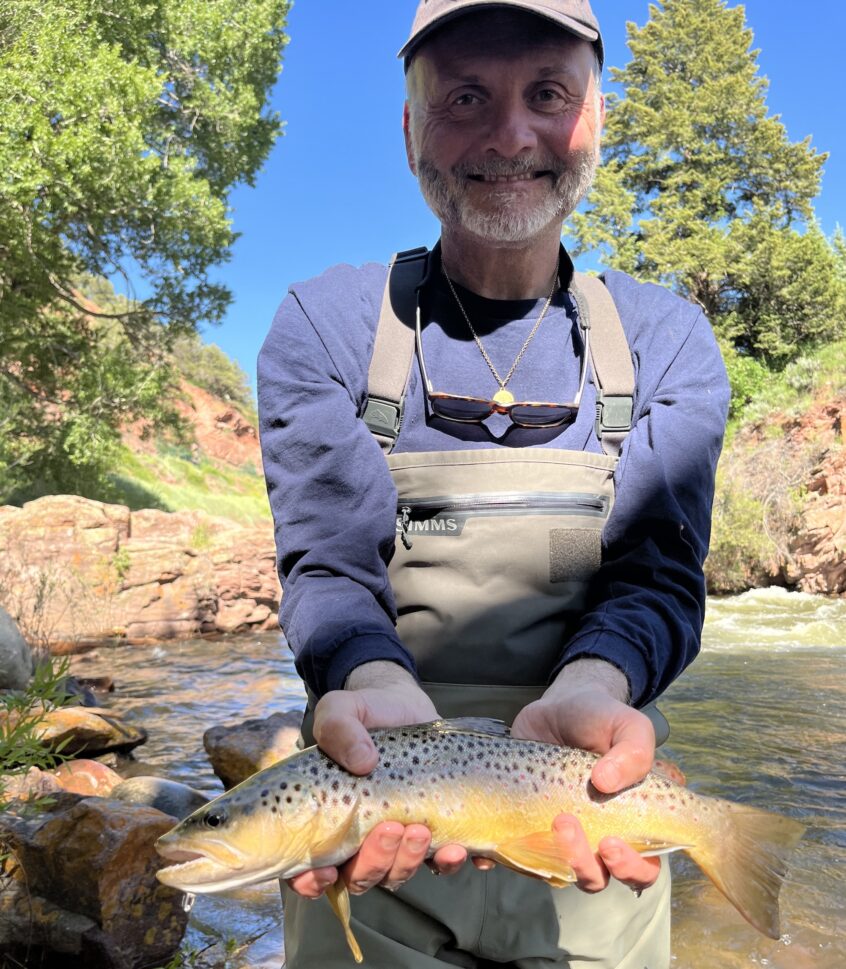Flows and Water Clarity
Flows are at 1020 cfs below Maroon Creek and 1750 cfs at Emma. Water clarity is improving daily!
Overview
Happy Fourth of July Weekend! After weeks of high water, it looks like the Roaring Fork is dropping! Flows have come down significantly in the last two days. With lower flows and better water clarity, it’s time to adjust rigs your rigs slightly. Though leading with larger bugs like stoneflies and worms will still catch fish, we’re starting to see a lot of caddis out there! Caddis nymphs like Guides Choice Hare’s Ears, Sparkle Caddis, UV Caddis, Dirty Birds and Plan B caddis have all been producing. Try fishing larger (size 12-14) caddis patterns as lead flies, or trail smaller caddis nymphs (size 16-18) behind a stone, worm or drake and see what works!
Due to snowmelt cycles, flows are highest in the morning and lowest in the afternoon, so adjust your rigs based on time of day and water clarity. Bigger bugs have been more effective early while switching to smaller, more natural patterns has worked best when the water is lower and temps are higher in the afternoon. It’s hard to say what the flows will do in the next week, but think about downsizing tippet if water clarity continues to improve.
Dry fly season should be in full swing soon! We’re seeing bugs hatching in larger numbers and fish have started feeding on the surface. If flows continue to drop, get out there and find the hatch! You might be rewarded with epic dry fly eats!
The Streamer fishing has been solid, but you’ll need to cover some water and focus on soft pockets off of the bank, eddies and seams that come off of structure. Use flashier streamers in murky water and smaller more natural colors if visibility is greater than a foot. If you’re fishing lower down on the Roaring Fork, you may even find some fish willing to eat a hopper-dropper set up. We promise you’ll have some fun mixing it up!
As always, be mindful of safety when out on the river. Despite the river slowing down somewhat, it’s still very powerful. Be sure to wear a wading belt when you fish, and don’t take any unnecessary risks when moving around the river. The fish are still pushed up against the bank during these flows! There’s no need to try to get out into the middle.
As mentioned above, conditions will probably be variable this week. If you want more in depth information on a specific day this week, give us a call or drop by the shop to get the most recent conditions and information.
Common Hatches and Food Sources
Caddis and Stoneflies
Nymphs like stones, caddis and worms (in poor visibility or after rain) are great patterns to fish this time of year. We’re seeing caddis get active on the fork, so fishing Hare’s Ears, Plan B Caddis, Frenchies, Sparkle Caddis, and UV Caddis has been working well. Any jigged flies with CDC have been working well too!
Hot flies & Techniques
Nymphs
Point Flies
Hot Flies: Guide’s Choice Hare’s ear (size 12-16), Plan B Caddis (size 12-16), Dirty Bird Caddis (size 14-16), 20 incher (size 8-14, natural), Pat’s Rubber Legs/Girdle Bug (size black, coffee, brown 6-14), Prince Nymph (size 8-16), Squirmy or San Juan Worm (Tan, Pink, Blood Worm).
Tungsten jigs with hot collars (yellow, brown, pink, size 12-16), Pheasant Tails (black, natural, flashback 12-16).
Dries:
Caddis are hatching on the fork, and we’ve been seeing some dry fly action in certain spots in the last few days. But, with water levels dropping we hope it’ll get really good in the next week or two! If you’re feeling adventurous and want to target hard to reach pockets right off the bank, tie on a Stimulator, Chubby or Hippy Stomper and drop a nymph off of it.
Hot Flies: Missing Link Caddis (14-16), Elk Hair Caddis (Tan, Olive 14-16) Royal Stimulator (classic or rubberlegs, (10-14)
Streamers:
Bring a streamer rod with you this time of year! It never hurts to target some structure and see what happens! It’s been a little streaky, but we love fishing streamers whenever we can!
Hot Flies: Sex Dungeons (White, Grizzly, Yellow, Black, Size 2) Mini Dungeons (white, natural, size 8), Thin Mint (size 8-10), Trick Or Treat (size 6), Mini Drunk and Disorderly (Olive, Yellow, size 8)
Motor Oil (black, size 6), Slumpbuster (natural, size 8-12),
Techniques
Nymphing is still the most productive technique during this time of year. Finding pockets of slower water and using weight to get your flies down will be crucial to success. Leading with larger jig style or tungsten patterns has been a very productive technique for getting your rigs into the strike zone.
Dry flies are starting to come into play now too. If you see fish rising, focus on getting a good drift and experiment with different patterns and colors until you get fish to eat. If you’re not seeing fish rise but bugs are hatching, cover a lot of water with a pattern that matches the hatch until you find some willing fish. Finally, using large dries like stimulators, hoppers and beetles in a dry-dropper rig is a fun way to mix it up and see what fish are responding to best.
Streamers are also an important tool in your toolbox during the summer! Small streamers with a slower retrieve tend to be best when the water is clear. In murky water, try the big nasty flashy stuff! It’s a ton of fun. Focus your efforts on deep pools and structure and cover a lot of water for the best results.
Information About The Roaring Fork
The Roaring Fork River is a freestone river that runs 70 miles from Independence Pass through Aspen, Basalt, and Carbondale until it reaches its confluence with the Colorado River in Glenwood Springs. The cold, clean waters of this famous river support an incredible array of aquatic life including brown, rainbow and cutthroat trout. The Roaring Fork is designated as a “Gold Medal” fishery, meaning it offers some of the best trout fishing in the nation to beginners and seasoned anglers alike.

